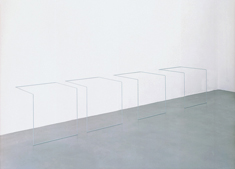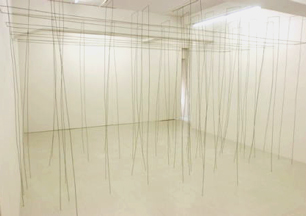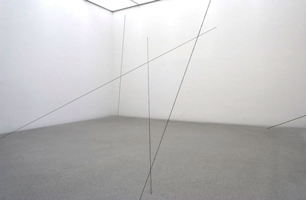
Currently – in the show ‘Raum der Linie‘ in Munich – I came across some works of Fred Sandback and was left stunned by two different facts: one the fragility, though absolute presence of these works and second – how could I have overlooked them for so long. Some works feel oddly familiar, like I have been seeing them before:
| Especially the four square pieces of half cubes which lean against the wall from 1969, but obviously was not too aware about them.
So now I am getting excited by discovering the artist’s work and will post some links here. The Whitechapel Gallery in London is also currently showing works from 1968 to 2001 from the artist, who passed away in 2003. |
 Fred Sandback ‘Cubes’ 1969 / 2001 |
| Using nothing but ‘air and edges’ he magically alters our experience of the space. In his words, ‘the inherent mysticism resides in persisting in wanting to make something as factual as possible and having it turn out just the other way… the realisation that the simplest and most comfortable of perceptions are shadows’. (excerpted from Whitechapel Gallery) |  Fred Sandback |
| “The first sculpture I made with a piece of string and a little wire was the outline of a rectangular solid . . . lying on the floor. It was a casual act, but it seemed to open up a lot of possibilities for me,” Fred Sandback wrote in 1986, looking back over twenty years of activity to a seminal sculpture he had executed in 1966.1 The key implications of that determining impulse remain at the heart of his practice today. In wanting to create sculpture that did not have an inside, he found through this seemingly “casual act” the means to “assert a certain place or volume in its full materiality without occupying and obscuring it.” (quote Fred Sandback; excerpted from the Dia Art Foundation) | |
| [..] Sandback was the anti-Serra. You’re never closed in, you’re never in danger, real or perceived, that tons of metal will come crashing down on you, and there’s nothing of the vertiginous thrill of curving and canted walls that challenge your relationship to perpendicular. |  Fred Sandback ‘Mikado’ 2003 |
| With Sandback’s work, you always know where you stand—but you may not be quite so sure of where it does. The momentary disjunct is transcendent. That’s an amazing sleight of hand for a few feet of yarn. (excerpted from Joanne Mattera Art Blog) | |
